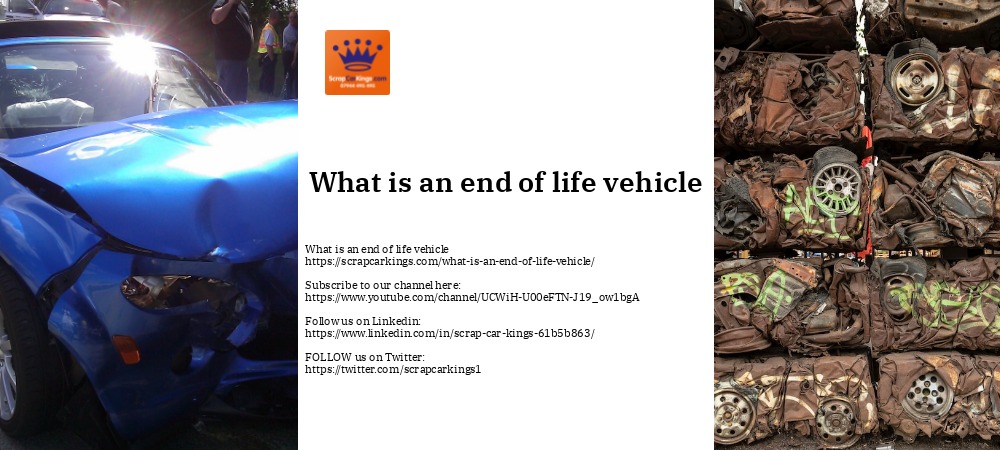What is an end of life vehicle

How do cars become end-of-life vehicles?
Motor vehicles that have come to the end of their useful life and are no longer roadworthy are classified as end-of-life vehicles or ELVs. In other words, an ELV is a motor vehicle that is beyond repair, or too old and inefficient to warrant the cost of repairs
The decision to classify a motor vehicle as an ELV is generally made by the owner when the vehicle is no longer roadworthy due to wear and tear, or accident damage. However, sometimes a company, such as an insurance company, will make the decision when they have taken legal ownership of an accident damaged car
ELVs can be old motor vehicles that are no longer efficient, or those that have been damaged in accidents. If you are looking to scrap your motor vehicle, you may come across terms such as ‘ELV’ online – in which case, this is what it refers to. End-of-life motor vehicles must be disposed of in an environmentally friendly manner, such as through a certified scrap yard. whole process from start to finish is important to us at Scrap Car Kings, which is why we make sure everything is done legally and correctly – ensuring peace of mind for you.
Different types of waste motor vehicles
End of Life Vehicles (ELVs) are waste motor vehicles that have reached the end of their useful life. All vehicle components and materials, including fluids, oils and gases, must be removed before the ELV is crushed and recycled
There are two main types of ELVs: those that have come to the end of their life naturally, and those that have been damaged prematurely. Natural ELVs are typically older cars that have sustained a lot of wear and tear over time. Premature ELVs, on the other hand, are younger vehicles that have been written off after an accident or damage
Both categories of ELVs can be scrapped, crushed and recycled to be given a new lease of life. The metal from an ELV can be melted down and reused to create new vehicle parts or other objects. Similarly, the plastic and rubber components can also be melted down and recycled into new products
Therefore it is important that they are disposed of correctly. recycling ELVs helps to reduce waste and pollution, and it also helps to conserve limited resources such as metals and plastics.
End of life vehicle disposal
When a car reaches the end of its life, it’s important to dispose of it properly to minimize its impact on the environment. In the UK, this means using Authorised Treatment Facility (ATF). Authorised treatment facilities are regulated to ensure that they follow best practices for scrapping cars & light commercial vehicles, including safe and ethical dismantling, de-pollution, crushing and recycling.
When a car is delivered to an ATF, it is considered hazardous waste and must be handled in accordance with end of life vehicle regulations. Once the ATF has confirmed that these regulations have been followed, a certificate of destruction (COD) is generated and the vehicle is deregistered. It’s crucial that scrap car waste is disposed of safely and responsibly to protect our planet.
The End of Life Vehicle Directive
The European Parliament targeted end-of-life vehicles as a priority waste stream in the early 1990s due to increasing concerns about disposal practices and poor environmental practices by traditional car breakers and scrap yards. In response, the ELV Directive was put into place in 1997 to help manage this waste and set clear recycling and recovery performance targets for ELVs and their parts.
Some of the directive’s goals include banning the use of harmful substances during production and manufacturing, as well as promoting the reuse, recycling, and recovery of automotive parts. Thanks to these efforts, the recovery and recycling rates of ELVs have increased significantly in recent years. However, there is still room for improvement, and the directive remains an important tool for ensuring that end-of-life vehicles are disposed of in a safe and environmentally-responsible manner.
What are the aims of the ELV Directive?
The European Union’s ELV Directive (end-of-life vehicles) is a set of regulations with the goal of reducing the environmental impact of motor vehicles at the end of their useful life. One of the key aspects of the Directive is to minimise waste and maximise recycling, with a target of 95% recycling by 2015. The Directive also sets standards for the materials and components that can be used in cars, with the aim of making them easier to recycle.
In addition, the Directive requires vehicle manufacturers to provide information to consumers about the environmental impact of their vehicles. By increasing recycling and reducing waste, the ELV Directive is working towards a more sustainable future for the automotive industry.
What is vehicle de-pollution?
The process of vehicle de-pollution basically involves two main functions: The recovery of all positive components and fluids that may be recycled and reused (e.g. fuels, oils, coolants, ferrous and non-ferrous metal components, etc.), and the removal of all hazardous substances that are potentially harmful to the environment (e.g. tyres, mercury switches, airbags, etc). In this way, vehicle de-pollution helps to ensure that end-of-life vehicles are dismantled and disposed of in an environmentally sound manner, thus helping to achieve recovery and recycling targets set by the ELV Directive.


